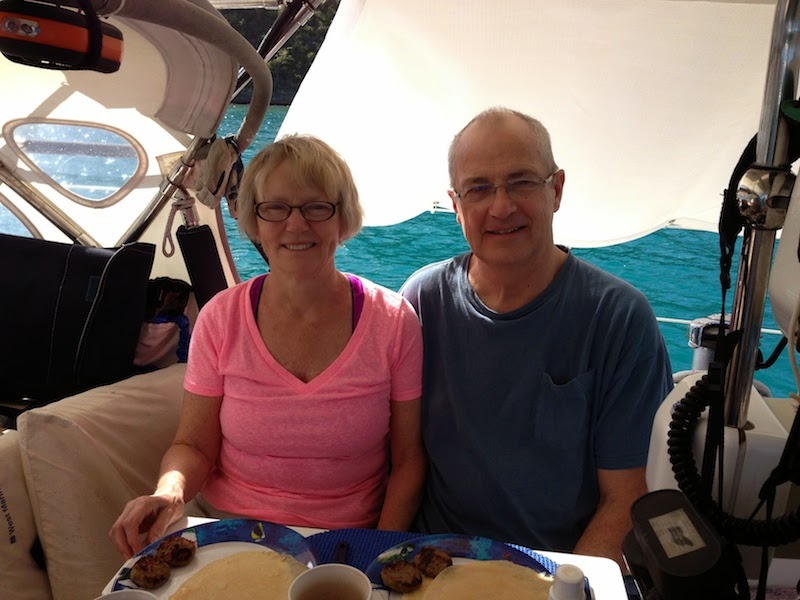Rod & Maryhelen are longtime friends. We raced T-birds against Rod and he later bought a Catalina 36 that was moored next to ours at Elliot Bay Marina in Seattle. We have so many great memories of sailing in the Gulf and San Juan Islands, as well as one of our favorite spots, Blakely Harbor on Bainbridge Island. (just a reach away) What a treat to have good friends as well as good sailors aboard!
As usual, our guests Rod & Maryhelen were bringing an extra suitcase to accommodate all the boat parts, etc. we coerced them into delivering. Luckily, Walter held off somewhat because we were traveling to the States shortly after their visit anyway. They had packed perfectly and all their belongings fit our guest berth's vanity table. It was all the other "stuff" we had to find a place for that is always the challenge. We proceeded to chat-a-way and get caught up with our families and grandkids over dinner and a couple glasses of wine.
We started putting together the week's sailing plan over breakfast and decided to spend another night at the Jolly Harbour Marina. We took a walk along beautiful Jolly Beach, relaxed by the poolside, and enjoyed the Crow's Nest restaurant for drinks and appetizers as the sun was setting. Rod and Maryhelen were starting to really relax and get into the cruising lifestyle.
 |
| Rod and Maryhelen at Jolly Beach |
Later that evening we had dinner at Nonsuch Bay Resort, an absolutely gorgeous resort built on the hillside and with a beautiful outdoor dining area overlooking the bay. We treated ourselves to delicious seafood dinners and couldn't have had a more enjoyable evening.
 |
| Tuna Steak Tartar |
Our sail back
towards Falmouth Harbor was much more fun with the wind on our
beam and we sailed twice as fast at 7-8 knots. Rod had a great time at
the helm and we arrived early into Falmouth Harbor, lies side-by-side with English Harbor. We anchored just outside the marina in front of some lovely homes overlooking a sandy beach and dinghied in to check out the beautiful yachts dockside.
Antigua is a great cruising island with more protected anchorages than any other Caribbean Island. The island is of course English and well known for attracting mega-yachts with marinas and services to accommodate cruisers of all levels. We wandered the docks watching all the crews working to keep the yachts in Bristol condition. Walt and Rod were overwhelmed by the wealth exhibited and the beauty and perfection of each yacht.
 |
| This yacht became an immediate favorite with its name, Go Seahawks! Note the matching red lines. |
Historic English Harbor Dockyard was once commanded by the famous British Naval Commander Horiato Nelson. The dockyards have undergone numerous renovations and are well preserved and managed by the Nelson's Dockyard National Park. We took a self-guided tour seeing the beautiful grounds and had a picnic later by the bay. Interestingly, a few ocean rowing boats racing in The Transatlantic Challenge had just arrived from the Azores and the harbor was swarming with media as scores of well wishers looked on.
 | |
| Would you like to live on this boat for 3 weeks? |
 |
| Two very happy English lads glad to be here in Antigua! |
 |
| Cheers! |
We had some great dinners out and I fixed up a chicken vegetable curry with rice one night. Maryhelen was a wonderful help in the galley, which makes such a difference. We had a movie night with popcorn and chocolates while we watched "Dead Men Don't Wear Plaid" and of course we rallied for a "Screw Your Buddy" card game that left us both frustrated with our guests card savvy. Good thing we weren't playing for cash!
After a couple days visiting English and Falmouth Harbors it was time to head back down to Jolly Harbor Marina and drop off Rod and Maryhelen. We had such a great time and wished the week wasn't over. They had wisely made reservations at a nearby resort to stay on the island another couple nights with the luxury of hot showers and spacious beds. I am sure the adventure has perked some further thought for more chartering in the tropics and hopefully they'll come and visit us again soon.
 |
| Great crew aboard Flying Cloud |



















































